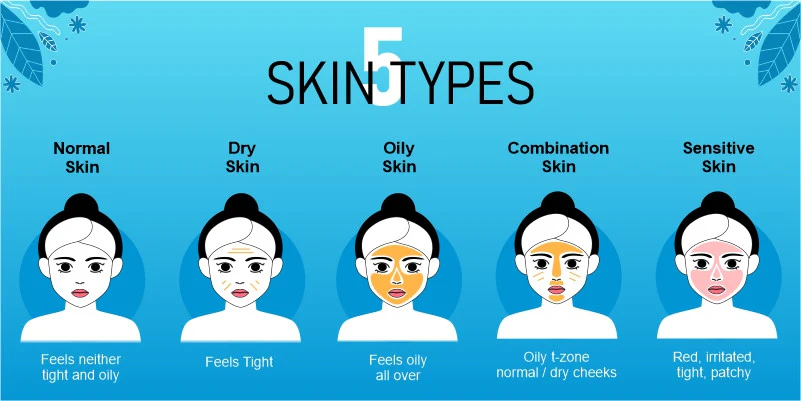Choosing the right skincare products can be overwhelming, especially with the countless options available. The key to success lies in understanding your skin type and selecting products that address your skin’s specific needs. Here’s a guide to help you choose the right skincare products based on your skin type.
1. Identifying Your Skin Type
Before diving into product selection, it’s essential to know your skin type. Most people fall into one of the following categories:
- Normal skin: Balanced, not too oily or dry.
- Oily skin: Shiny, especially in the T-zone (forehead, nose, and chin), prone to acne and enlarged pores.
- Dry skin: Feels tight, flaky, or rough, with more visible fine lines.
- Combination skin: Oily in the T-zone, but dry or normal in other areas.
- Sensitive skin: Prone to redness, irritation, or allergic reactions.
To identify your skin type, cleanse your face and wait for an hour. Assess how your skin feels without any products—this will give you a clear indication of your type.
2. Cleansers: Choose the Right One for Your Skin
Cleansers are the foundation of any skincare routine, as they remove dirt, oil, and impurities.
- For oily skin: Use a gel or foaming cleanser with salicylic acid to control oil production and prevent breakouts.
- For dry skin: Opt for a hydrating, cream-based cleanser that won’t strip your skin of moisture. Look for ingredients like hyaluronic acid or glycerin.
- For combination skin: Use a gentle foaming cleanser that balances oil and hydration.
- For sensitive skin: Choose a fragrance-free, hypoallergenic cleanser with soothing ingredients like aloe vera or chamomile.
- For normal skin: A gentle cleanser with minimal ingredients will do the job.
Tip: Avoid cleansers with harsh sulfates or alcohol, as these can irritate your skin, regardless of skin type.
3. Toners: Balance Your Skin
Toners are optional but can offer additional benefits, especially for those with oily or combination skin.
- For oily skin: Look for toners with ingredients like witch hazel or niacinamide to control oil and tighten pores.
- For dry skin: Choose hydrating toners with ingredients like rose water or hyaluronic acid.
- For combination skin: A balancing toner with mild astringents or hydrating agents works best.
- For sensitive skin: Stick to alcohol-free toners with calming properties, like calendula or green tea.
- For normal skin: Use a refreshing toner that helps maintain your skin’s natural balance.
Tip: Apply toner right after cleansing to remove any remaining residue and prepare your skin for serums and moisturizers.
4. Serums: Target Specific Skin Concerns
Serums are lightweight and contain potent active ingredients to address specific skin concerns, from acne to anti-aging.
- For oily skin: Choose serums with niacinamide or retinol to regulate oil production and reduce breakouts.
- For dry skin: Look for hydrating serums with hyaluronic acid or ceramides to lock in moisture.
- For combination skin: A vitamin C serum can brighten the skin without causing excess oil or dryness.
- For sensitive skin: Use serums with calming ingredients like aloe, centella asiatica, or peptides.
- For normal skin: A multi-purpose serum with antioxidants like vitamin C can help maintain healthy skin.
Tip: Apply serums before your moisturizer for maximum absorption.
5. Moisturizers: Keep Your Skin Hydrated
A good moisturizer is essential for all skin types to lock in hydration and protect the skin’s barrier.
- For oily skin: Opt for an oil-free, lightweight gel moisturizer that hydrates without clogging pores. Ingredients like hyaluronic acid and glycerin work well.
- For dry skin: Choose a rich, creamy moisturizer with ingredients like shea butter or ceramides to deeply nourish your skin.
- For combination skin: Use a balancing moisturizer that’s lightweight but hydrating, such as a gel-cream.
- For sensitive skin: Look for fragrance-free, hypoallergenic moisturizers with soothing ingredients like oat extract or allantoin.
- For normal skin: A simple moisturizer with antioxidants and hydration-boosting ingredients is ideal.
Tip: Always moisturize your skin after applying serums to lock in hydration and keep your skin soft.

6. Sunscreen: Protect Your Skin Every Day
Sunscreen is a crucial step in any skincare routine, protecting your skin from harmful UV rays and preventing premature aging.
- For oily skin: Choose a non-comedogenic, oil-free sunscreen with a matte finish.
- For dry skin: Opt for a hydrating sunscreen with added moisturizers to prevent dryness.
- For combination skin: Use a lightweight sunscreen that won’t clog pores or feel too heavy.
- For sensitive skin: Look for mineral-based sunscreens with zinc oxide or titanium dioxide to avoid irritation.
- For normal skin: A broad-spectrum sunscreen with SPF 30 or higher will provide adequate protection.
Tip: Reapply sunscreen every two hours, especially if you’re spending time outdoors.
7. Exfoliators: Revitalize Your Skin
Exfoliating helps remove dead skin cells, promoting a smoother complexion. However, it’s important to choose the right exfoliator for your skin type and not overdo it.
- For oily skin: Use chemical exfoliants like salicylic acid or glycolic acid to help unclog pores and control oil.
- For dry skin: Opt for gentle, enzyme-based exfoliators to avoid irritating or drying out your skin further.
- For combination skin: A mild exfoliant with a blend of acids or enzymes can help balance oil and dry areas.
- For sensitive skin: Stick to gentle, non-abrasive exfoliants like lactic acid or fruit enzymes.
- For normal skin: You can use either a physical scrub or chemical exfoliant once or twice a week.
Tip: Limit exfoliation to 2-3 times a week to avoid damaging your skin’s barrier.
Conclusion
Selecting the right skincare products starts with knowing your skin type and understanding its needs. By choosing cleansers, toners, serums, moisturizers, and sunscreens that suit your specific skin type, you can create a skincare routine that keeps your skin healthy, glowing, and balanced.



